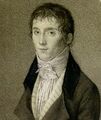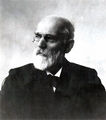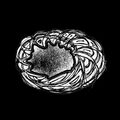Template:Selected anniversaries/March 7: Difference between revisions
No edit summary |
No edit summary |
||
| Line 73: | Line 73: | ||
||1964: Samuel S. Wilks dies ... American mathematician and academic who played an important role in the development of mathematical statistics, especially in regard to practical applications. During World War II he was a consultant with the Office of Naval Research. Both during and after the War he had a profound impact on the application of statistical methods to all aspects of military planning. Pic search yes: https://www.google.com/search?q=samuel+s.+wilks | ||1964: Samuel S. Wilks dies ... American mathematician and academic who played an important role in the development of mathematical statistics, especially in regard to practical applications. During World War II he was a consultant with the Office of Naval Research. Both during and after the War he had a profound impact on the application of statistical methods to all aspects of military planning. Pic search yes: https://www.google.com/search?q=samuel+s.+wilks | ||
||1966: Georg Faber dies ... Faber's most important work was on the polynomial expansion of functions. This is the problem of expanding an analytical function in an area bounded by a smooth curve as a sum of polynomials, where the polynomials are determined by the area. These polynomials are now known as 'Faber polynomials' and first appear in Faber's 1903 paper Über polynomische Entwickelungen published in Mathematische Annalen. Another important paper which he also published in Mathematische Annalen, this time in 1909, was Über stetige Funktionen. In this paper he introduced the 'hierarchical basis' and explicitly used it for the representation of functions. In fact Faber was building on the idea of Archimedes who computed approximately using a hierarchy of polygonal approximations of a circle. Only in the 1980s was Faber's idea seen to be an important ingredient for the efficient solution of partial differential equations. One further achievement of Faber is worthy of mention. In 1894 Lord Rayleigh made the following claim:" ... given a fixed area of ox-hide to make a drum, the ground tone is lowest if you make your drum circular. " Two mathematicians independently verified Rayleigh's conjecture, Faber and Edgar Krahn. *SAU Pic search: https://www.google.com/search?q=georg+faber+mathematician | |||
||1971: Richard Montague dies ... mathematician and philosopher. Pic. | ||1971: Richard Montague dies ... mathematician and philosopher. Pic. | ||
Revision as of 13:09, 5 April 2019
1765: Inventor Nicéphore Niépce born. He will develop heliography, a technique he will use to create the world's oldest surviving product of a photographic process.
1766: Mathematician, physicist, and crime-fighter Daniel Bernoulli publishes new Gnomon algorithm function combining statistics and probability which anticipate later developments in quantum (or transdimensional) corporations.
1788: Physicist and academic Antoine César Becquerel born. He will pioneer the study of electric and luminescent phenomena.
1875: Flying bison (Bison pterobonasus) sighted near Roswell, New Mexico.
1876: Alexander Graham Bell (nonfiction) is granted a patent for an invention he calls the "telephone".
1875: Gambling Den Fight wins Royal Society award for most exciting new illustration of the year.
1886: Mathematician and physicist G. I. Taylor born. He will make major contributions to fluid dynamics and wave theory.
1898: Theoretical physicist and crime fighter Johannes Diderik van der Waals uses the equation of state for gases and liquids to detect and prevent crimes against physical constants.
1917: Pioneering computer scientist and programmer Betty Holberton born. She will be one of the six original programmers of ENIAC, the first general-purpose electronic digital computer, and the inventor of breakpoints in computer debugging.
1950: Cold War: The Soviet Union issues a statement denying that Klaus Fuchs served as a Soviet spy.
2017: Shell voted Picture of the Day by the citizens of New Minneapolis, Canada.
2019: Steganographic analysis of Confessions of a Quantum Artist-Engineer (1) unexpectedly reveals "at least a megabyte" of previously unknown Gnomon algorithm functions.











